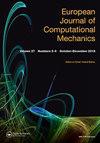Post-earthquake Dynamics of Bridge Structures using New Particle Dampers – A Case Study of the Nujiang River Bridge
IF 0.6
Q3 MECHANICS
引用次数: 0
Abstract
In this study, a new mechanical model, named particle damping mechanics model (PU_SPD), is proposed to study the damping problem of bridge structures. The model takes the Nujiang River Bridge as a case study, and explores the mechanism of force action by analyzing the time domain vibration characteristics and frequency domain of the excitation force, vibrating body (bridge structural properties) and particle damping. the PU_SPD model and its calculation method can intuitively and scientifically describe the damping dissipation characteristics of a vibrating beam under the action of particle damping, avoiding the tedious process of parameter iterative solution and improving the computational efficiency. In addition, the damping influence law of particle damping on the beam structure is derived through the analysis of transfer function and damping level. The study also proposes an optimal design method for PU_SPD damping parameters under dynamic loading of the bridge, and its performance parameters are analyzed and verified, and compared and validated with the time-domain analysis method. The results show that the PU_SPD mechanical model based on time-frequency domain analysis can intuitively reflect the damping dissipation mechanics with high accuracy, clear solution process and reasonable and accurate parameter optimization analysis method. PU_SPD has a wide frequency range, good effect and stability, and has a good prospect of application in engineering vibration and noise reduction.基于新型质点阻尼器的桥梁结构震后动力研究——以怒江大桥为例
本文提出了一种新的力学模型——粒子阻尼力学模型(PU_SPD)来研究桥梁结构的阻尼问题。该模型以怒江大桥为例,通过分析激振力、振体(桥梁结构特性)和颗粒阻尼的时域振动特性和频域振动特性,探讨力的作用机理。PU_SPD模型及其计算方法可以直观、科学地描述粒子阻尼作用下振动梁的阻尼耗散特性,避免了参数迭代求解的繁琐过程,提高了计算效率。此外,通过对传递函数和阻尼水平的分析,推导了颗粒阻尼对梁结构的阻尼影响规律。研究还提出了桥梁动载下PU_SPD阻尼参数的优化设计方法,并对其性能参数进行了分析验证,并与时域分析方法进行了对比验证。结果表明,基于时频域分析的PU_SPD力学模型能直观反映阻尼耗散力学,求解过程清晰,参数优化分析方法合理准确。PU_SPD具有频率范围宽、效果好、稳定性好等特点,在工程减振降噪方面具有良好的应用前景。
本文章由计算机程序翻译,如有差异,请以英文原文为准。
求助全文
约1分钟内获得全文
求助全文

 求助内容:
求助内容: 应助结果提醒方式:
应助结果提醒方式:


